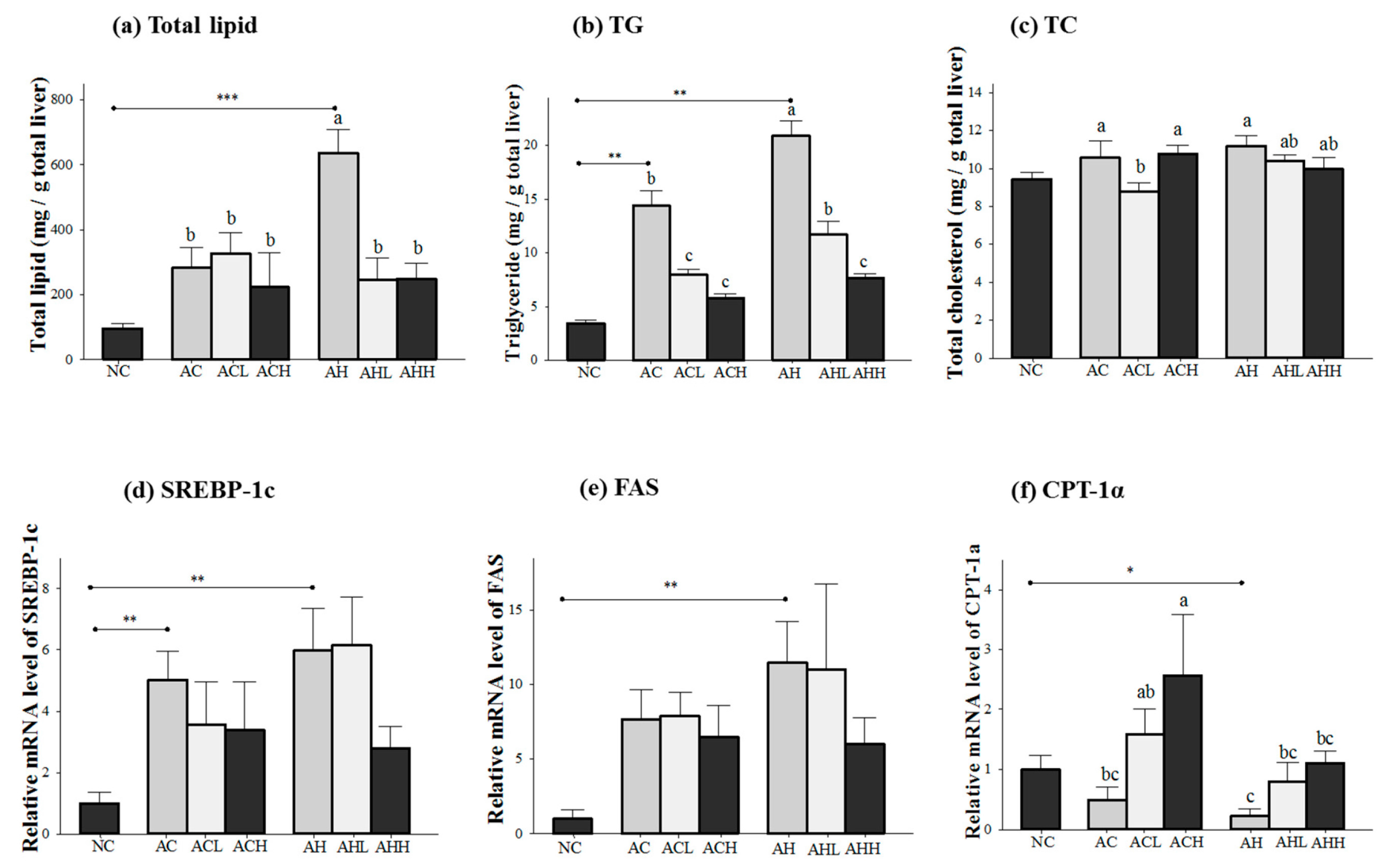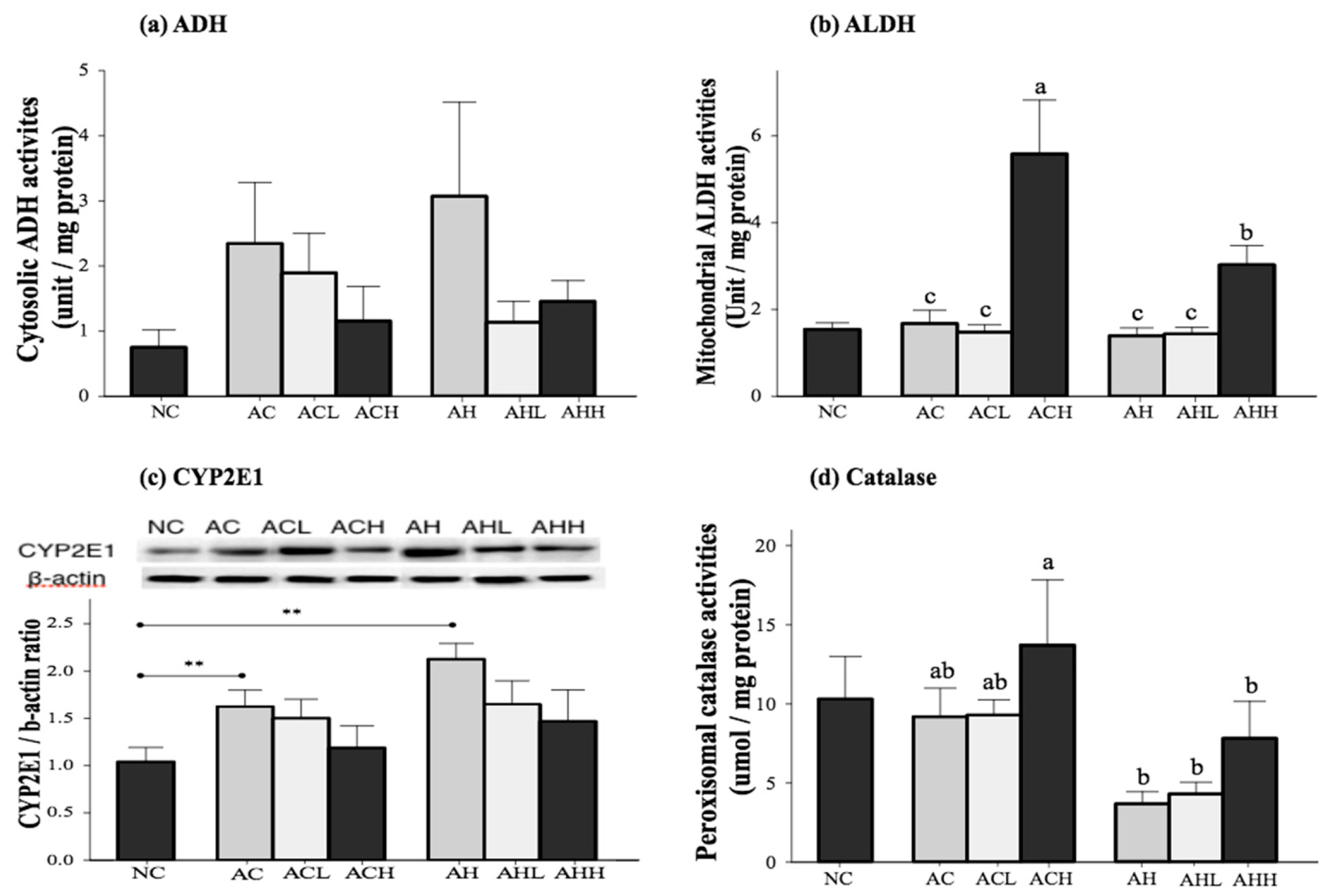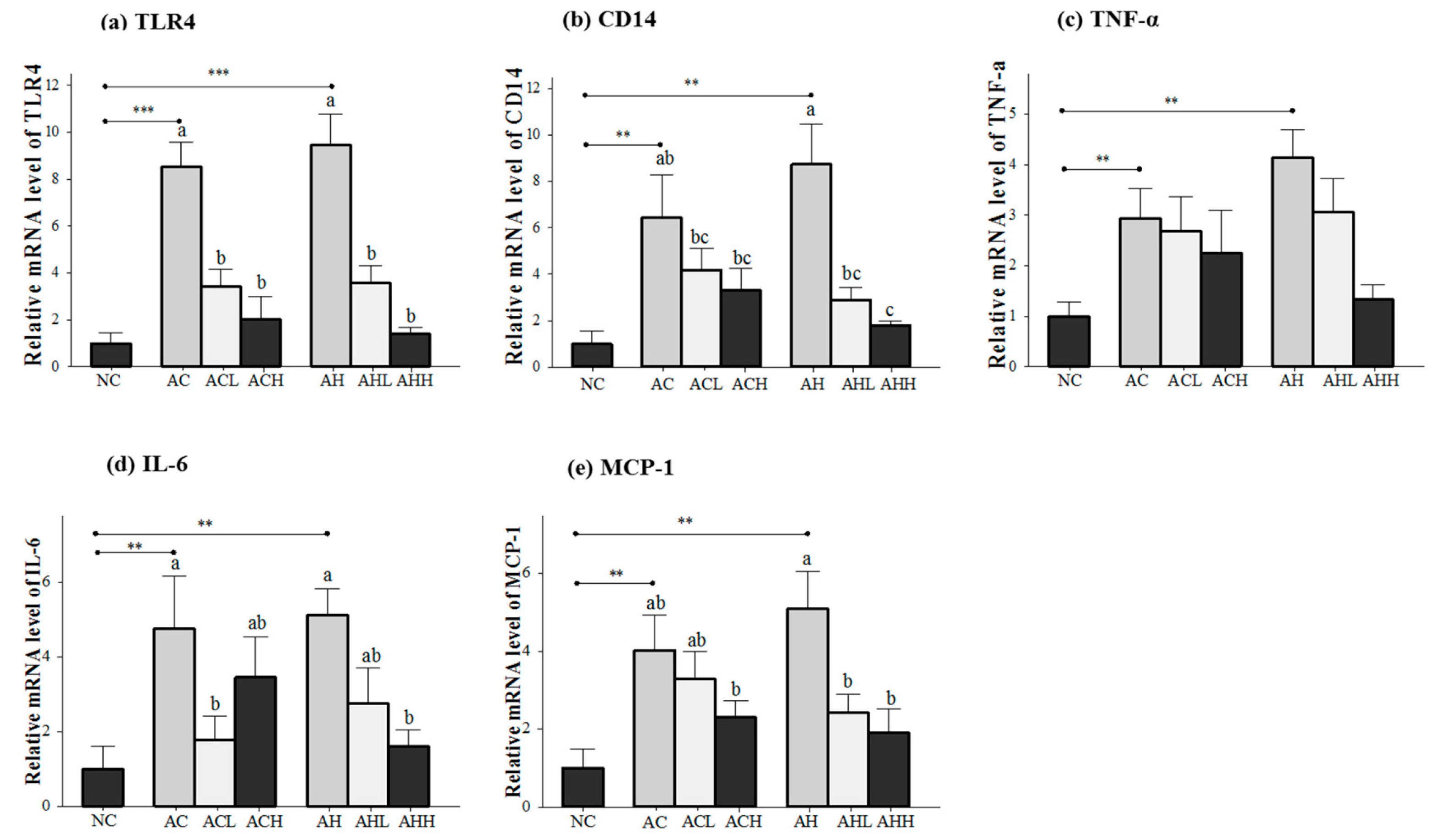Ethanolic Extract of Acanthopanax koreanum Nakai Alleviates Alcoholic Liver Damage Combined with a High-Fat Diet in C57BL/6J Mice
Abstract
:1. Introduction
2. Results
2.1. Effect of AK on Alcohol and HFD-Induced Hepatic Steatosis
2.2. Effect of AK on Lipid and Alcohol Metabolism in Alcohol and HFD-Induced Hepatic Steatosis
2.3. Effect of AK on Hepatic Inflammatory Responses in Alcohol and HFD-Induced Hepatic Steatosis
3. Discussion
4. Materials and Methods
4.1. AK Preparation
4.2. Animals and Diets
4.3. Histological Analysis
4.4. Preparation of Cytosol, Microsome, Peroxisome and Mitochondria Fractions in the Liver
4.5. Biochemical Assays
4.6. Western Blot Analysis
4.7. Total RNA Isolation and Quantitative Real-Time Reverse Transcription Polymerase Chain Reaction Analysis
4.8. Statistical Analysis
5. Conclusions
Acknowledgments
Author Contributions
Conflicts of Interest
Abbreviations
| ADH: | alcohol dehydrogenase |
| AK: | Acanthopanax koreanum Nakai |
| ALD: | alcoholic liver disease |
| ALDH: | acetaldehyde dehydrogenase |
| ALT: | alanine aminotransferase |
| AST: | aspartate aminotransferase |
| CAT: | catalase |
| CD14: | cluster of differentiation 14 |
| CPT-1α: | carnitine palmitoyltransferase 1α |
| CYP2E1: | cytochrome P450 2E1 |
| FAS: | fatty acid synthase |
| HFD: | high-fat diet |
| MCP-1: | monocyte chemotactic protein-1 |
| MyD88: | myeloid differentiation factor 88 |
| NAFLD: | nonalcoholic fatty liver disease |
| NF-κB: | nuclear factor kappa-light-chain-enhancer of activated B cells |
| IL-6: | interluekin-6 |
| LPS: | lipopolysaccharide |
| ROS: | reactive oxygen species |
| SREBP-1c: | sterol regulatory element-binding protein-1c |
| STAT-3: | signal transducer and activator of transcription-3 |
| TC: | total cholesterol |
| TG: | triglyceride |
| TLR4: | toll-like receptor 4 |
| TNF-α: | tumor necrosis factor- α |
| TRIF: | TIR domain-containing adapter-inducing interferon |
References
- Ramaiah, S.; Rivera, C.; Arteel, G. Early-phase alcoholic liver disease: An update on animal models, pathology, and pathogenesis. Int. J. Toxicol. 2004, 23, 217–231. [Google Scholar] [CrossRef] [PubMed]
- Rutkowski, J.M.; Stern, J.H.; Scherer, P.E. The cell biology of fat expansion. J. Cell Bio. 2015, 208, 501–512. [Google Scholar] [CrossRef] [PubMed]
- Beier, J.I.; Arteel, G.E.; McClain, C.J. Advances in alcoholic liver disease. Curr Gastroenterol. Rep. 2011, 13, 56–64. [Google Scholar] [CrossRef] [PubMed]
- Demori, I.; Voci, A.; Fugassa, E.; Burlando, B. Combined effects of high-fat diet and ethanol induce oxidative stress in rat liver. Alcohol 2006, 40, 185–191. [Google Scholar] [CrossRef] [PubMed]
- Lee, I.S.; Park, S.; Park, K.; Choue, R. Hepatoprotective activity of scutellariae radix extract in mice fed a high fat diet with chronic alcohol exposure. Phytother. Res. 2011, 25, 1348–1353. [Google Scholar] [CrossRef] [PubMed]
- Gäbele, E.; Dostert, K.; Dorn, C.; Patsenker, E.; Stickel, F.; Hellerbrand, C. A new model of interactive effects of alcohol and high-fat diet on hepatic fibrosis. Alcohol Clin. Exp. Res. 2011, 35, 1361–1367. [Google Scholar] [CrossRef] [PubMed]
- Nan, J.X.; Park, E.J.; Nam, J.B.; Zhao, Y.Z.; Cai, X.F.; Kim, Y.H.; Sohn, D.H.; Lee, J.J. Effect of Acanthopanax koreanum Nakai (Araliaceae) on d-galactosamine and lipopolysaccharide-induced fulminant hepatitis. J. Ethnopharmacol. 2004, 92, 71–77. [Google Scholar] [CrossRef] [PubMed]
- Nan, J.X.; Jin, X.J.; Lian, L.H.; Cai, X.F.; Jiang, Y.Z.; Jin, H.R.; Lee, J.J. A diterpenoid acanthoic acid from Acanthopanax koreanum protects against d-galactosamine/lipopolysaccharide-induced fulminant hepatic failure in mice. Biol. Pharm. Bull. 2008, 31, 738–742. [Google Scholar] [CrossRef] [PubMed]
- Kang, J.S.; Linh, P.T.; Cai, X.F.; Kim, H.S.; Lee, J.J.; Kim, Y.H. Quantitative determination of eleutheroside B and E from Acanthopanax species by high performance liquid chromatography. Arch. Pharm. Res. 2001, 24, 407–411. [Google Scholar] [CrossRef] [PubMed]
- Phuong, N.T.; Lee, K.A.; Jeong, S.J.; Fu, C.X.; Choi, J.K.; Kim, Y.H.; Kang, J.S. Capillary electrophoretic method for the determination of diterpenoid isomers in Acanthopanax species. J. Pharm. Biomed. Anal. 2006, 40, 56–61. [Google Scholar] [CrossRef] [PubMed]
- Yamazaki, T.; Shimosaka, S.; Sasaki, H.; Matsumura, T.; Tukiyama, T.; Tokiwa, T. (+)-Syringaresinol-di-O-beta-d-glucoside, a phenolic compound from Acanthopanax senticosus Harms, suppresses proinflammatory mediators in SW982 human synovial sarcoma cells by inhibiting activating protein-1 and/or nuclear factor-kappaB activities. Toxicol. In Vitro 2007, 21, 1530–1537. [Google Scholar] [CrossRef] [PubMed]
- Nhiem, N.X.; Tung, N.H.; Kiem, P.V.; Minh, C.V.; Ding, Y.; Hyun, J.H.; Kang, H.K.; Kim, Y.H. Lupane triterpene glycosides from leave of Acanthopanax koreanum and their cytotoxic activity. Chem. Pharm. Bull. (Tokyo) 2009, 57, 986–989. [Google Scholar] [CrossRef] [PubMed]
- Schmolz, M.W.; Sacher, F.; Aicher, B. The synthesis of Rantes, G-CSF, IL-4, IL-5, IL-6, IL-12 and IL-13 in human whole-blood cultures is modulated by an extract from Eleutherococcus senticosus L. roots. Phytother. Res. 2001, 15, 268–270. [Google Scholar] [CrossRef] [PubMed]
- Kim, K.J.; Hong, H.D.; Lee, O.H.; Lee, B.Y. The effects of Acanthopanax senticosus on global hepatic gene expression in rats subjected to heat environmental stress. Toxicology 2010, 278, 217–223. [Google Scholar] [CrossRef] [PubMed]
- Wu, Y.L.; Jiang, Y.Z.; Jin, X.J.; Lian, L.H.; Piao, J.Y.; Wan, Y.; Jin, H.R.; Joon Lee, J.; Nan, J.X. Acanthoic acid, a diterpene in Acanthopanax koreanum, protects acetaminophen-induced hepatic toxicity in mice. Phytomedicine 2010, 17, 475–479. [Google Scholar] [CrossRef] [PubMed]
- Yang, Y.K.; Lin, W.; Kwon, O. Protective effects of Acanthopanax koreanum Kakai extract against carbon tetrachloride-induced liver injury in Sprague-Dawley rats. J. Nutr. Health 2014, 47, 106–112. [Google Scholar] [CrossRef]
- Jung, M.G.; Do, G.M.; Shin, J.H.; Ham, Y.M.; Park, S.Y.; Kwon, O. Acanthopanax koreanum Nakai modulates the immune response by inhibiting TLR 4-dependent cytokine production in rat model of endotoxic shock. Nutr. Res. Pract. 2013, 7, 460–465. [Google Scholar] [CrossRef] [PubMed]
- Su-Hong, C.; Qi, C.; Bo, L.; Jian-Li, G.; Jie, S.; Gui-Yuan, L. Antihypertensive Effect of Radix Paeoniae Alba in Spontaneously Hypertensive Rats and Excessive Alcohol Intake and High Fat Diet Induced Hypertensive Rats. Evid. Based. Complement. Altern Med. 2015, 2015. [Google Scholar] [CrossRef] [PubMed]
- Tahir, M.; Rehman, M.U.; Lateef, A.; Khan, R.; Khan, A.Q.; Qamar, W.; Ali, F.; O'Hamiza, O.; Sultana, S. Diosmin protects against ethanol-induced hepatic injury via alleviation of inflammation and regulation of TNF-alpha and NF-kappaB activation. Alcohol 2013, 47, 131–139. [Google Scholar] [CrossRef] [PubMed]
- Botros, M.; Sikaris, K.A. The de ritis ratio: The test of time. Clin. Biochem. Rev. 2013, 34. [Google Scholar]
- Purohit, V.; Gao, B.; Song, B.J. Molecular mechanisms of alcoholic fatty liver. Alcohol. Clin. Exp. Res. 2009, 33, 191–205. [Google Scholar] [CrossRef] [PubMed]
- Nebert, D.W.; Dalton, T.P. The role of cytochrome P450 enzymes in endogenous signalling pathways and environmental carcinogenesis. Nat. Rev. Cancer 2006, 6, 947–960. [Google Scholar] [CrossRef] [PubMed]
- Edenberg, H.J. The genetics of alcohol metabolism: Role of alcohol dehydrogenase and aldehyde dehydrogenase variants. Alcohol Res Health 2007, 30, 5–13. [Google Scholar] [PubMed]
- Hung, H.C.; Chuang, J.; Chien, Y.C.; Chern, H.D.; Chiang, C.P.; Kuo, Y.S.; Hildesheim, A.; Chen, C.J. Genetic polymorphisms of CYP2E1, GSTM1, and GSTT1; environmental factors and risk of oral cancer. Cancer Epidemiol. Biomark. Prev. 1997, 6, 901–905. [Google Scholar]
- Maher, J. The CYP2E1 knockout delivers another punch: First ASH, now NASH. Alcoholic steatohepatitis. Nonalcoholic steatohepatitis. Hepatology 2001, 33, 311–312. [Google Scholar] [CrossRef] [PubMed]
- Leung, T.M.; Nieto, N. CYP2E1 and oxidant stress in alcoholic and non-alcoholic fatty liver disease. J. Hepatol. 2013, 58, 395–398. [Google Scholar] [CrossRef] [PubMed]
- Handler, J.A.; Thurman, R.G. Redox interactions between catalase and alcohol dehydrogenase pathways of ethanol metabolism in the perfused rat liver. J. Biol. Chem. 1990, 265, 1510–1515. [Google Scholar] [PubMed]
- Szabo, G.; Bala, S. Alcoholic liver disease and the gut-liver axis. World J. Gastroenterol. 2010, 16, 1321–1329. [Google Scholar] [CrossRef] [PubMed]
- Gäbele, E.; Brenner, D.A.; Rippe, R.A. Liver fibrosis: Signals leading to the amplification of the fibrogenic hepatic stellate cell. Front Biosci. 2003, 8, d69–d77. [Google Scholar] [PubMed]
- Kleiner, D.E.; Brunt, E.M.; van Natta, M.; Behling, C.; Contos, M.J.; Cummings, O.W.; Ferrell, L.D.; Liu, Y.C.; Torbenson, M.S.; Unalp-Arida, A.; et al. Design and validation of a histological scoring system for nonalcoholic fatty liver disease. Hepatology 2005, 41, 1313–1321. [Google Scholar] [CrossRef] [PubMed]
- Volkl, A.; Fahimi, H.D. Isolation of peroxisomes. Cell Biol. A Lab. Handb. 1998, 2, 87–92. [Google Scholar]
- Bonnichsen, R.K.; Brink, N.G. [78] Liver alcohol dehydrogenase. Methods Enzymol. 1955, 1, 495–500. [Google Scholar]
- Koivula, T.; Koivusalo, M. Different forms of rat liver aldehyde dehydrogenase and their subcellular distribution. Biochim. Biophys. Acta 1975, 397, 9–23. [Google Scholar] [CrossRef]
- Johansson, L.H.; Borg, L.H. A spectrophotometric method for determination of catalase activity in small tissue samples. Anal. Biochem. 1988, 174, 331–336. [Google Scholar] [CrossRef]
- Sample Availability: Not available.




| Groups | NC | Alcohol Ingestion Group | |||||
|---|---|---|---|---|---|---|---|
| AC | ACL | ACH | AH | AHL | AHH | ||
| Food intake | 2.73 ± 0.04 | 2.49 ± 0.12 a | 2.34 ± 0.09 a | 2.34 ± 0.05 a | 2.05 ± 0.04 b,*** | 1.93 ± 0.02 b | 1.86 ± 0.04 b |
| Initial body weight | 22.83 ± 0.48 | 22.73 ± 0.51 | 23.15 ± 0.43 | 22.91 ± 0.60 | 23.14 ± 0.41 | 23.16 ± 0.34 | 23.22 ± 0.37 |
| Final body weight | 24.43 ± 0.26 | 24.07 ± 0.40 | 23.49 ± 0.38 | 22.64 ± 0.31 | 24.01 ± 0.24 | 23.50 ± 0.31 | 23.61 ± 0.28 |
© 2016 by the authors. Licensee MDPI, Basel, Switzerland. This article is an open access article distributed under the terms and conditions of the Creative Commons Attribution (CC-BY) license ( http://creativecommons.org/licenses/by/4.0/).
Share and Cite
Kim, H.; Park, M.; Shin, J.-H.; Kwon, O. Ethanolic Extract of Acanthopanax koreanum Nakai Alleviates Alcoholic Liver Damage Combined with a High-Fat Diet in C57BL/6J Mice. Molecules 2016, 21, 681. https://doi.org/10.3390/molecules21060681
Kim H, Park M, Shin J-H, Kwon O. Ethanolic Extract of Acanthopanax koreanum Nakai Alleviates Alcoholic Liver Damage Combined with a High-Fat Diet in C57BL/6J Mice. Molecules. 2016; 21(6):681. https://doi.org/10.3390/molecules21060681
Chicago/Turabian StyleKim, Haein, Minyoung Park, Jae-Ho Shin, and Oran Kwon. 2016. "Ethanolic Extract of Acanthopanax koreanum Nakai Alleviates Alcoholic Liver Damage Combined with a High-Fat Diet in C57BL/6J Mice" Molecules 21, no. 6: 681. https://doi.org/10.3390/molecules21060681
APA StyleKim, H., Park, M., Shin, J.-H., & Kwon, O. (2016). Ethanolic Extract of Acanthopanax koreanum Nakai Alleviates Alcoholic Liver Damage Combined with a High-Fat Diet in C57BL/6J Mice. Molecules, 21(6), 681. https://doi.org/10.3390/molecules21060681







